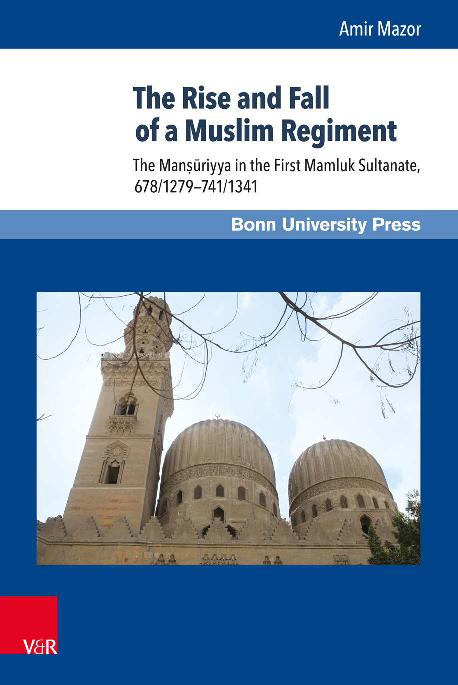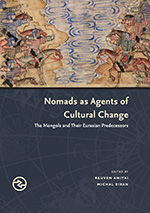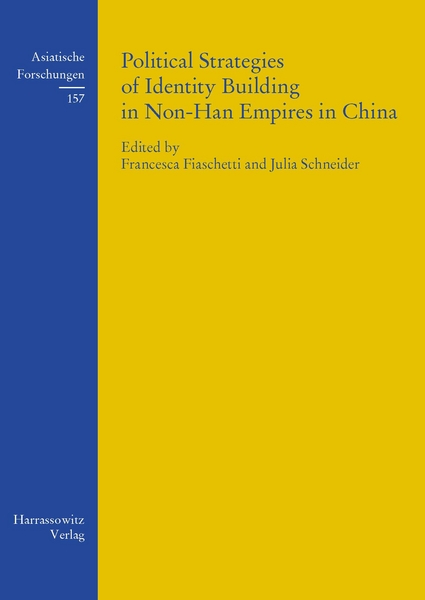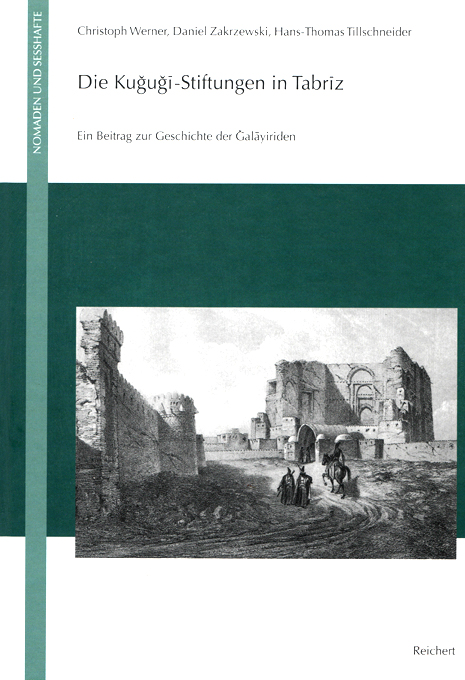Recent Publications




31/12/2017
A special section of the Asiatische Studien / Études Asiatiques, edited by Michal Biran and titled "In the Service of the Khans: Elites in Transition in Mongol Eurasia" appeared in November 2017. The issue includes papers of Michal Biran and many alumni members of the Jerusalem Mongol project: Daniel Zakrzewski, Or Amir, Choi Soyoung, Francesca Fiaschetti, Florence Hodous, Geoffrey Humble, Vered Shurany, Ishayahu Landa, Cho Wonhee and Yang Qiao. The exact content can be download here.
31/03/2017
Two new papers of Dr. Yoichi Isahaya, our team member, appeared recently.
Isahaya, Yoichi and Jyuh Fuh Lin, “Entangled Representation of Heaven: A Chinese Divination Text from a Tenth-Century Dunhuang Fragment (P. 4071),” Historia Scientiarum 26/3 (2017): 153–171.
Isahaya, Yoichi and Mitsuaki Endo, "Persian Transcription of Yuan Chinese in the History of China of the Jāmi‘ al-Tawārīkh (Ms. Istanbul, Topkapı Sarayı, Hazine 1654)," The Economic Review 経済研究 9 (2017), pp. 123–161.
07/01/2017
A new paper of Ishayahu Landa, our team members, appeared recently. The full text of the article is available to the download via the hyperlink below.
Ishayahu Landa, "Oirats in the Ilkhanate and the Mamluk Sultanate in the Thirteenth to the Early Fifteenth Centuries: Two Cases of Assimilation into the Muslim Environment," Mamluk Studies Review 19 (2016), pp. 149-191.
14/11/2016
A paper of Ishayahu Landa, our team member, appeared recently.
Ishayahu Landa, "Imperial Sons-in-Law on the Move: Oyirad and Qonggirad Dispersion in Mongol Eurasia," Archivum Eurasiae Medii Aevi 22 (2016), pp. 161-198.
4/08/2016
A paper of our new team member, Dr. Jonathan Brack, appeared recently. The exact title of the paper is:
Jonahan Brack, “Was Ede Bali a Wafāʾī Shaykh? Sufis, Sayyids and Genealogical Creativity in the Early Ottoman World,” Andrew C.S. Peacock and Sara Nur Yildiz (eds.), Literature and Intellectual Life in Islamic Anatolia, 14th-15th centuries (Würzburg: Ergon Verlag, 2016), pp. 333-60.
01/07/2016
Four new publications of our team member Dr. Qiu Yihao appeared recently. The titles are:
Qiu Yihao, “A Short Report on Qaraqorum in al-Yūnīnī’s Dhail Mir’āt al-Zamān: on the Contemporary Arabic Maritime Merchants of Marco Polo,” in Xu Zhongwen, Rong Xinjiang et al. (eds.), Make Boluo Yangzhou Sichou zhi lu (Beijing: Beijing University Press, 2016), pp. 327-342.
Qiu Yihao, “The Mission of Fakhr al-Dīn Aḥmad al-Ṭībī: A Resurvey on the Ilkhan’s Envoy to Yuan Court in 1298,” Bulletin of Sinonica, Taibei, 2016, 87:1. [《大德二年(1298)伊利汗国遣使元朝考——法合鲁丁·阿合马·惕必的出使及其背景》,台北:《中央研究院历史语言研究所集刊》,2016年,第八十七本第1分。]
Qiu Yihao, “Mongol Empire in the view of Saʿdī’s Poems,” Wen hui, Shanghai: Janu. 2016. [《萨迪诗歌中的蒙古帝国》,上海:《文汇报·学人》,2016年1月29日。]
Qiu Yihao, “Historiography and Political Identity: Introduction of Shuʿab-i Panjgāna,” A fresh insight into the Silk Road research through the Bowl of Jamshid (Jām-i Jam): Collection of Papers on Iranian Strudies, ed. by Cheng tong, Shanghai: Zhong xi shu ju, 2016. [《〈五族谱〉研究导论——研究史·文献特征·史料价值》,程彤编,《丝绸之路上的照世杯: “中国与伊朗——丝绸之路上的文化交流” 国际研讨会论文集》,上海:中西书局,2016。]
5/05/2016
Two members of our project, Prof. Michal Biran and Dr. Florence Hodous, contributed to the recently appeared book under the editorship of Prof. Charles Melville and Dr, Bruno De Nicola (Bruno Di Nicola and Charles Melville (eds.), The Mongols' Middle East: Continuity and Transformation in Ilkhanid Iran (Leiden: Brill, 2016). ISBN: 9789004311992.). The exact titles of the papers are:
- Biran, Michal, "Music in the Mongol Conquest of Baghdad: Ṣafī al-Dīn Urmawī and the Ilkhanid Circle of Musicians," in Bruno De Nicola and Charles Melville (eds.), The Mongols' Middle East: Continuity and Transformation in Ilkhanid Iran (Leiden: Brill, 2016), pp. 131-154. doi: 10.1163/9789004314726_008
- Hodous, Florence, "Faith and the Law: Religious Beliefs and the Death Penalty in the Ilkhanate," in Bruno Nicola and Charles Melville (eds.), The Mongols' Middle East: Continuity and Transformation in Ilkhanid Iran (Leiden: Brill, 2016), pp. 106-129. doi: 10.1163/9789004314726_007
22/03/2016
A new paper of our team member Dr. Yoichi Isayaha, written in the cooperation with Dr. Mitsuaki Endo (Aoyama Gakuin University, Tokyo) and titled "Yuan Phonology as Reflected in Persian Transcription in the Zīj-i Īlkhānī" has recently appeared in the Keizai Kenkuy 経済研究 8 (2016), pp. 1-38.
Additionally, a new translation of Dr. Isahaya appeared as well: Nasrollah Pourjavady, Yoichi Isahaya (trans.), "Izutsu's Interest in Iranian Mystical Philosophy." In Towards a Philosophy of Co-Existence: a Dialogue with Iran-Islam (2), Journal of International Philosophy, Extra Issue 7 (2016): 68–77.
01/12/2015
A new paper of our team member Dr. Florence Hodous, titled "Clash or Compromise? Mongol and Muslim Law in the Ilkhanate (1258-1335)", has appeared in the Studies on the Iranian World II: Medieval and Modern, A. Krasnowolska, R. Rusek-Kowalska, eds. (Krakow: Jagiellonian University Press, 2015), pp. 187-196.
The file is uploaded on this website on the permission of the author.
10/10/2015
A new book, The Rise and Fall of a Muslim Regiment: The Manṣūriyya in the First Mamluk Sultanate, 678/1279–741/1341, authored by Dr. Amir Mazor, member of the project, appeared few weeks ago in the Vandenhoeck & Ruprecht. The TOC can be downloaded here, a short reading probe can be found on the academia.edu page of the author. The introductory text of the publishing house:
This book focuses on the Manṣūriyya regiment, the mamluks of sultan al-Manṣūr Qalāwūn. It traces the lives of these mamluks during the career of their master Qalāwūn (ca. 1260–1290), the period they ruled the Sultanate of Egypt and Syria de jure or de facto (1290–1310), and their aftermath, during the third reign of sultan al-Nāṣir Muḥammad b. Qalāwūn (1310–1341). Based on dozens of contemporary Arabic sources, the book traces the political and military events of the turbulent Manṣūriyya period, as well as the basic military-political principles and socio-political practices that evolved during this period. It suggests that the Manṣūriyya period marks the beginning of the demilitarization, or politicization, of the Mamluk sultanate.
1/03/2015
A new paper of our team member, Dr. Francesca Fiaschetti, appeared recently in the Ming Qing yanjiu. The exact title of the paper is:
The paper investigates some aspects of Yuan diplomatic rhetoric on the basis of diplomatic correspondence with Annam and Koryŏ, as reported in the Yuan shi and in other Chinese documents from the Yuan period. These sources show that Qubilai’s diplomacy was constructed on Mongolian patterns of foreign relations and representations of charismatic rulership. At the same time, the founder of the Yuan dynasty promoted his imperial identity by adopting several topoi of Confucian rhetoric in order to gain legitimacy in the eyes of the neighbouring lands as successor to the Song dynasty. By showing the entanglement of these two perspectives, the paper demonstrates the necessity to go beyond the sole context of Chinese culture, and the idea of sinicization, when reading Chinese sources on the Yuan. In doing so, the paper contributes new ideas to the ongoing debate on the analysis of periods of non-Han rule in China.
07/02/2015
A new book, Nomads as Agents of Cultural Change: The Mongols and Their Eurasian Predecessors, co-authored by Prof. Michal Biran and Prof. Reuven Amitai, appeared recently in the University of Hawaii Press. The TOC can be downloaded here. The introductory text of the publishing house says:
Since the first millennium BCE, nomads of the Eurasian steppe have played a key role in world history and the development of adjacent sedentary regions, especially China, India, the Middle East, and Eastern and Central Europe. Although their more settled neighbors often saw them as an ongoing threat and imminent danger—“barbarians,” in fact—their impact on sedentary cultures was far more complex than the raiding, pillaging, and devastation with which they have long been associated in the popular imagination. The nomads were also facilitators and catalysts of social, demographic, economic, and cultural change, and nomadic culture had a significant influence on that of sedentary Eurasian civilizations, especially in cases when the nomads conquered and ruled over them. Not simply passive conveyors of ideas, beliefs, technologies, and physical artifacts, nomads were frequently active contributors to the process of cultural exchange and change. Their active choices and initiatives helped set the cultural and intellectual agenda of the lands they ruled and beyond.
This volume brings together a distinguished group of scholars from different disciplines and cultural specializations to explore how nomads played the role of “agents of cultural change.” The beginning chapters examine this phenomenon in both east and west Asia in ancient and early medieval times, while the bulk of the book is devoted to the far flung Mongol empire of the thirteenth and fourteenth centuries. This comparative approach, encompassing both a lengthy time span and a vast region, enables a clearer understanding of the key role that Eurasian pastoral nomads played in the history of the Old World. It conveys a sense of the complex and engaging cultural dynamic that existed between nomads and their agricultural and urban neighbors, and highlights the non-military impact of nomadic culture on Eurasian history.
Nomads As Agents of Cultural Change illuminates and complicates nomadic roles as active promoters of cultural exchange within a vast and varied region. It makes available important original scholarship on the new turn in the study of the Mongol empire and on relations between the nomadic and sedentary worlds.
03/09/2014
A new article, "Fortuna e Ideologia Imperiale nei Documenti di Epoca Yuan," authored by our team member Francesca Fiaschetti appeared in the collection of the papers of the 14th Congress of the Italian Association of the Chinese Studies. The whole collection, including the article of Francesca, can be found via the following link:
03/09/2014
A new book, Political Strategies of Identity Building in Non-Han Empires in China, co-authored by our team member Francesca Fiaschetti was published by Otto Harrassowitz Publishing House in August. The book includes two pieces written by Francesca: Introduction, co-authored with Julia Schneider (pp. 1-8) and The Borders of Rebellion: The Yuan Dynasty and the Rhetoric of Empire (pp. 127-146).
Long periods in Chinese history were determined by non-Han conquest rule. With this volume, which emerged from a workshop held in Munich in 2012, its editors and contributors aim at removing the blinders imposed by modern histories and their national boundaries, both territorial and intellectual, and at challenging the way in which we have thought and written about Chinese history so far.
All chapters take a close look at the ways non-Han rulers, be they Jurchen, Mongols, or Manchus, used their specific cultural-ethnic backgrounds to strengthen their power in East Asia. Moreover, through a syncretic approach to the rhetoric and ideologies of other groups under their rule, the emperors and ruling elites developed invigorating methods to deal with the multi-ethnic and multi-cultural compositions of their often huge empires, whose influence is to be seen even in nowadays China. Only if we take their Inner and Northern Asian backgrounds into account will we be able to fully understand the historical and cultural impact of these dynasties on East Asian history. By doing so, the analysis of these periods must necessarily move beyond the focus of a China-centered narrative and take into account that the non-Han and Han identities of conquerors and conquered populations coming into contact became part of each other’s histories. A closer look at these mutual influences will also enhance our understanding of these crucial historical periods beyond the limits of a perspective solely oriented towards ethnic and political boundaries.
(Abstract taken from the official page of the Harrassowitz Publishing House)
18/07/2014
A new article, "Reading the Yuan Sky: Semu Astronomers and Cultural Exchange in Yuan China", was published recently by the member of our team, Yang Qiao, in the 14th volume of the Journal of the Yuan History [Yuanshi Luncong 元史论丛]. The full text of the article in Chinese can be downloaded from our website by the permission of the author.
Yang Qiao, "Reading the Yuan Sky: Semu Astronomers and Cultural Exchange in Yuan China” (解读元朝的天空——色目天文学家与元代文化交流), Journal of the Yuan History (Yuanshi Luncong 元史论丛) 14 (2014), pp. 390-401 (published in Chinese).
26/06/2014
A new article, "The Quriltai as a Legal Institution in the Mongol Empire", published by our project's member Florence Hodous appeared recently in the vol. 56 of Central Asiatic Journal. The full text of the article can be found here by the permission olf the author.
The legal nature of the quriltai can be seen from the fact that it gave legal force to decisions, whether these were about succession, military campaigns, or legal trials. Good attendance at a quriltai allowed the decisions taken to be perceived as legal as well as binding on all who had participated. Thus, the quriltai and the collegial decision-making underpinning it are valuable evidence of how the Mongols perceived legality and practiced law.
Hodous, Florence. "The Quriltai as a Legal Institution in the Mongol Empire," Central Asiatic Journal 56 (2012/2013), pp. 87-102.
04/05/2013
A new book, co-authored by team member Daniel Zakrzewski has just been published.
Die Kujuji-Stiftungen in Tabriz: Ein Beitrag zur Geschichte der Jalayiriden (Wiesbaden: Dr. Ludwig Reichert Verlag, 2013), by Christoph Werner, Daniel Zakrzewski and Hans-Thomas Tillschneider, includes an Arabic edition, translation into German and extensive commentary of a waqf deed from 780/1380 Tabriz. The waqf founder, Khwaja Shaikh Kujuji, was a political advisor to the Jalayirid rulers of post-Ilkhanid Tabriz, aw well as a poet, and a charismatic sheikh. The study sheds new light on the post-mongol history of Iran and the early history of the Safavids.
